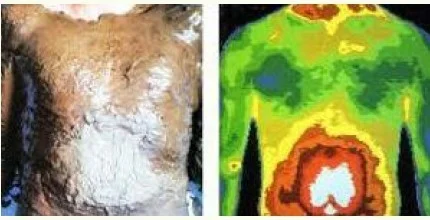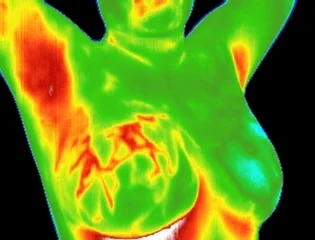Thermographic image of a patient with implants
According to women’s health specialist, Dr. Christine Horner, thermography can “detect breast cancers much earlier than any other available technology. Because blood vessels ordinarily start to grow before any other significant changes and tumor growth, a thermogram can ‘see’ these abnormal physiological processes as early as 5-10 years before a cancer can be seen by a mammogram, MRI, or ultrasound or felt by a physical exam. What is most exciting is that when these abnormal processes are caught this early they are reversible.” (15) This gives time for natural interventions such as diet, supplementation and lifestyle changes like stress management to heal the body.
_________________________________________________________________________
Jessica Luibrand attended Grand Valley State University where she received her Bachelor’s degree in Health Sciences with a double minor in Biology and Sociology. She is currently employed as Chief Clinical Thermographer and Subtle Energy Researcher at Psy-Tek Subtle Energy Laboratory. Her mission is to combine her love of health and wellness with her love of people.
_________________________________________________________________
Editor’s note: According to the American College of Clinical Thermography (ACCT), “One day there may be a single method for the early detection of breast cancer. Until then, using a combination of methods will increase your chances of detecting cancer in an early state.”16 The ACCT suggests an annual thermography screening, mammography when appropriate, and regular breast exams.
The ACCT explains that most women use thermography in addition to mammography and/or ultrasound. They believe thermal imaging should be “viewed as a complementary, not competitive, tool to mammography and ultrasound” that can increase the effectiveness of those two structural tests by identifying patients having the highest risk level.17
The International Academy of Clinical Thermography says that thermography is not a replacement for mammography because “there is no one test that can detect 99-100% of all cancers.” In addition, thermography and mammography “are ‘looking’ for completely different pathological processes” because one tests physiology and the other tests anatomy. Lastly, they explain that “thermography is far more sensitive than mammography; however, some slow growing non-aggressive cancers will only be detected by mammography.”18
Breast cancer detection is a multifaceted issue that requires an individualized approach. Each person must make their own decision and stay aware of the most current research. Because cancer screening is a billion dollar industry, it can be difficult to obtain unbiased information.19
Screening measures such as mammography and thermography can be beneficial tools for detection, depending on the circumstances. Use of one or the other, or both, depends on a variety of factors, such as age, history of disease, disease status, type of cancer, density of breast tissue and more. Remember that thermography or mammograms or breast exams cannot diagnose cancer. In the end, if something suspicious is found on a mammogram, or by ultrasound, breast exam or thermography, the definitive diagnosis can only be done by biopsy.
Sources:
1. “American Cancer Society Releases New Breast Cancer Guideline,” American Cancer Society, accessed February 20, 2016, http://www.cancer.org/cancer/news/news/american-cancer-society-releases-new-breast-cancer-guidelines.
2. “Aphorisms by Hippocrates,” The Internet Classics Archives, accessed February 21, 2016, http://classics.mit.edu/Hippocrates/aphorisms.4.iv.html.
3. Rebecca SY Wong, “Apoptosis in cancer: from pathogenesis to treatment,” Journal ofExperimental and Clinical Cancer Research, 30(1) (2011): 87.
4. “M. Retsky, PhD. Cancer Growth Implication for Medicine and Malpractice White Paper,” Technical Assistance Bureau, accessed February 21, 2016, http://www.lectlaw.com/filesh/tabtumo.htm.
5. “Screening for Breast Cancer with Mammography,” Cochrane, accessed February 21, 2016, http://www.cochrane.org/CD001877/BREASTCA_screening-for-breast-cancer-with-mammography.
6. AH Lee, “Why is carcinoma of the breast more frequent in the upper outer quadrant? A case series based on needle core biopsy diagnoses,” Breast, 14(2) (2005): 151-2.
7. “Accuracy of Mammograms,” Susan G. Koman, accessed February 21, 2016, http://ww5.komen.org/BreastCancer/AccuracyofMammograms.html.
8. “Mammograms Fact Sheet,” National Cancer Institute, accessed February 21, 2016, http://www.cancer.gov/types/breast/mammograms-fact-sheet.
9. Johannes P. van Netten, Stephen A. Cann and James G. Hall,“Mammography Controversies: Time for Informed Consent?”Oxford Journals Medicine & Health: Journal of National Cancer Institute, 89 (15) (1997): 1164-1165.
10. “Breast Screening Questions and Answers,” American College of Clinical Thermography, accessed February 21, 2016, http://www.thermologyonline.org/Breast/breast_q_a/bqa_clinicaltests.htm.
11. Y.R. Parisky, A. Sardi, R. Hamm, K. Hughes, L. Esserman, S. Rust and K.Callahan, “Efficacy of Computerized Infrared Imaging Analysis to Evaluate Mammographically Suspicious Lesions.” American Journal of Roentgenolgy 180 (January 2003).
12. N. Arora, "Effectiveness of a Noninvasive Digital Infrared Thermal Imaging System in the Detection of Breast Cancer," The American Journal of Surgery (October 1, 2008): 523-26.
13. “Breast Screening Questions and Answers,” American College of Clinical Thermography, accessed February 21, 2016, http://www.thermologyonline.org/Breast/breast_q_a/bqa_accurate.htm.
14. D. Kolaric et al. “Thermography- A Feasible Method for Breast Cancer Screening?” Collegium Anthropologicum 37 (2013): 583-588.
15. Christine Horner, Waking the Warrior Goddess: Dr. Christine Horner's Program to Protect Against and Fight Breast Cancer, (New Jersey: Basic Health Publications, 2005), 21.
16. “Early Detection Guidelines,” American College of Clinical Thermography, accessed February 21, 2016, http://www.thermologyonline.org/Breast/breast_thermography_detection.htm.
17. “Mammography vs. Thermography,” International Academy of Clinical Thermography, accessed February 21, 2016, http://www.iact-rg.org/patients/breastthermography/mammography-vs-therm.html.
18. “Breast Screening Questions and Answers,” American College of Clinical Thermography, accessed February 21, 2016, http://www.thermologyonline.org/Breast/breast_q_a/bqa_replacement.htm.
19. ”Largest, Longest Study on Mammograms Finds No Benefit, “Mercola.com, accessed February 21, 2016, http://articles.mercola.com/sites/articles/archive/2014/02/26/mammograms.aspx.




